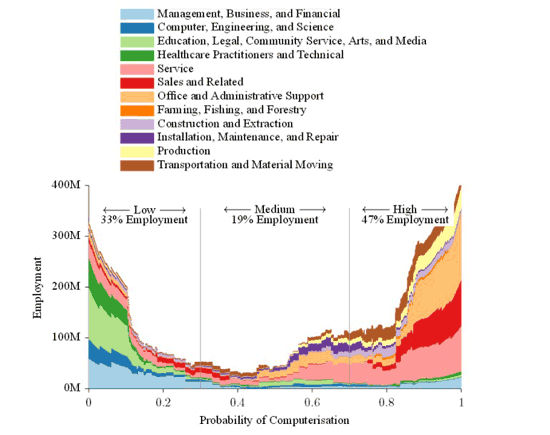September 27, 2013
A study titled "The Future of Employment: How Susceptible Are Jobs to Computerisation?" from Oxford University reports than nearly half of jobs in the United States are at risk of being computerized within two decades. Included in the jobs that could be potentially automated are cognitive tasks that could soon be performed using Big Data analytics. Jobs that are at the highest risk of being computerized include those in the fields of logistics, transportation, and administrative support.
While more complex jobs tied to engineering, creativity, and social intelligence are safer in the near term, those jobs could potentially be automated in the longer term, the report suggests. Nevertheless, nonroutine tasks, ranging from legal writing to medical diagnoses, could soon automated, the authors argue. This is similar to how nineteenth-century technology caused a "deskilling" of labor, leading the factory to displace the artisan workshop. Similarly, others have recently argued that the widespread proliferation of consumer computing horsepower could lead to a deskilling of medicine, giving consumers access to ever-more powerful health-monitoring tools and diagnostic capability. On a related note, the study authors quote Eli Whitney, cotton gin inventor, who said that technology could "substitute correct and effective operations of machinery for the skill of the artist which is acquired only by long practice and experience; a species of skill which is not possessed in this country to any considerable extent."

The report, written by Carl Benedikt Frey and Michael A. Osborne, asserts that highly educated professionals with high incomes are generally less likely to have their job computerized than those with minimal incomes and education. The study was motivated by John Maynard Keynes's prediction of technological unemployment spurred by the pace of cost-efficient automation developing faster than the rate at which society can find new employment opportunities. This trend has been exemplified in the recent past as positions such as bank tellers have been displaced by technology such as ATMs, online banking, and financial software.
Further evidence for this thesis comes in the form of U.S. employment trends following the Great Recession. As The New York Times recently reported: "the United States still has two million fewer jobs than before the downturn, the unemployment rate is stuck at levels not seen since the early 1990s and the proportion of adults who are working is four percentage points off its peak in 2000."
About the Author(s)
You May Also Like


